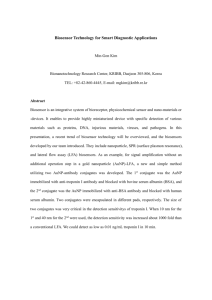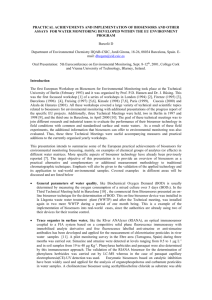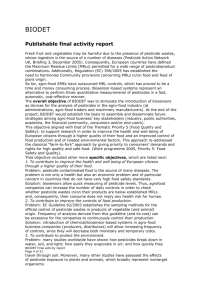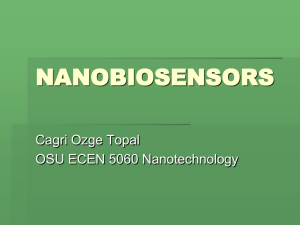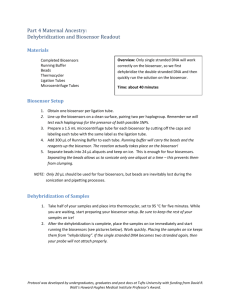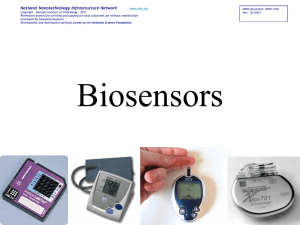Current Opinion Polizzi Kontoravdi Final - Spiral
advertisement
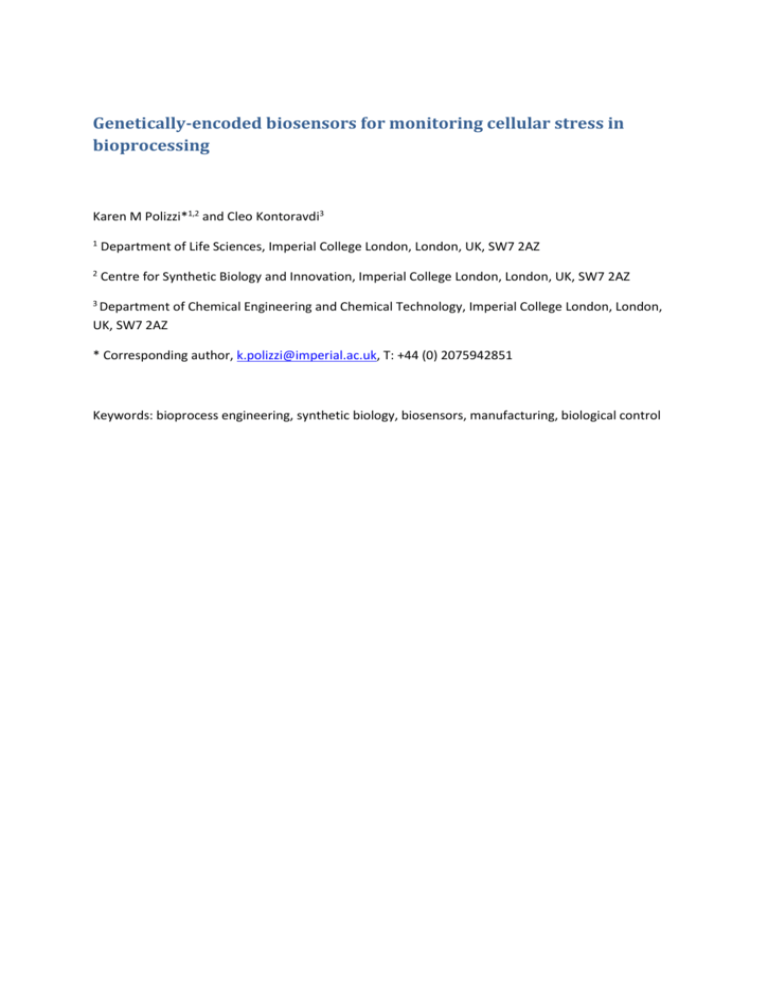
Genetically-encoded biosensors for monitoring cellular stress in bioprocessing Karen M Polizzi*1,2 and Cleo Kontoravdi3 1 Department of Life Sciences, Imperial College London, London, UK, SW7 2AZ 2 Centre for Synthetic Biology and Innovation, Imperial College London, London, UK, SW7 2AZ 3 Department of Chemical Engineering and Chemical Technology, Imperial College London, London, UK, SW7 2AZ * Corresponding author, k.polizzi@imperial.ac.uk, T: +44 (0) 2075942851 Keywords: bioprocess engineering, synthetic biology, biosensors, manufacturing, biological control Abstract With the current wealth of transcriptomic data, it is possible to design genetically-encoded biosensors for the detection of stress responses and apply these to high-throughput bioprocess development and monitoring of cellular health. Such biosensors can sense extrinsic factors such as nutrient or oxygen deprivation and shear stress, as well as intrinsic stress factors like oxidative damage and unfolded protein accumulation. Alongside, there have been developments in biosensing hardware and software applicable to the field of genetically-encoded biosensors in the near future. This review discusses the current state-of-the-art in biosensors for monitoring cultures during biological manufacturing and the future challenges for the field. Connecting the individual achievements into a coherent whole will enable the application of genetically-encoded biosensors in industry. Introduction The efficient development of industrial processes for manufacturing biological products remains a challenge. Ensuring batch-to-batch reproducibility and maximising the yield from production vessels requires both a systematic investigation of the best operating parameters during process development and analysis of cultures during production to ensure quality. High-throughput culture systems such as the Micro-24 MicroReactor System (Pall Life Sciences), the AmbrTM workstation (TAP Biosystems) and the BioLector® (m2p-labs) can accelerate process development. These systems allow monitoring of, and in some cases control over, temperature, dissolved oxygen and pH. The low culture volume, however, makes it difficult to obtain samples for other analyses. In situ sensing of analytes of interest is therefore an attractive option for real-time high-throughput data generation from such platforms, because it removes the need for sampling. The same sensors can then be used to monitor cultures during production to confirm that the analytes remain within the limits necessary to maintain productivity and take corrective action when they do not. There are several studies outlining recent developments in biosensor design and application to bioprocessing, including biosensors to directly sense key nutrients, such as sugars and amino acids (e.g. glucose and glutamine biosensors [1], and other efforts recently reviewed in [2]). In addition to metabolism, effectors of the unfolded protein response have been shown to positively correlate with specific productivity of recombinant proteins [3-5], while oxidative damage from metabolism and/or protein misfolding can accumulate over time, leading to redox imbalance and eventually cell death [6,7] . Extrinsic process parameters such as shear stress, nutrient and oxygen depletion can also affect performance by activating cellular stress responses. This review focuses on the use of genetically-encoded biosensors to sense extrinsic and intrinsic cellular stress, which can indicate the need to change operating parameters in order to improve cell health and productivity. Biosensors can also be used to establish the limits of feasible operating parameters and for high throughput design of media. We have focused on biosensors that rely on the activation of transcription as their output, as these can be developed from the wealth of information from recent transcriptomic studies of stress responses (e.g [8-11]) in a relatively modular fashion (Figure 1). Genetically-encoded biosensors are pieces of DNA that contain the instructions for a biosensor circuit. The output of the circuit is usually a reporter protein that is easy to detect. The classical example is the green fluorescent protein (GFP) and its derivatives. Others include enzymes that catalyse a reaction that produces a colour change (alkaline phosphatase, beta-galactosidase, etc.) and luciferase, which utilises the substrate luciferin, ATP, and oxygen to produce a detectable light signal. In order to monitor dynamic variations, reporter proteins can be destabilised through the addition of degradation tags ([12-14]). Progress in the development of relevant biosensors I am fine/ I am not fine: Generic reporters as a marker of ‘well-being’ Stress leads to changes in gene expression that can impact global transcription. Thus, one strategy for determining if a cell is ‘well’ is to monitor the production of a constitutively expressed reporter protein. Sudden changes in reporter expression could indicate a negative change in the environment of the cell that requires intervention. This strategy has been applied in several cell types [15-17]. However, this type of biosensor cannot give a specific indication of what needs to be changed in order ameliorate the environment. Similarly, global stress regulators can be used as the basis for a biosensor. One such study in E coli revealed induction of stress responses in poorly mixed environments, suggesting a global indicator of poor conditions. However, the experiments also showed that a fraction of the population lost its ability to induce the stress response, a consideration for the use of this design [18]. Exploiting stress signalling to create specific biosensors In Nature, poor environments activate signalling pathways designed to upregulate transcription of the genes necessary to deal with the resulting stress. Some examples relevant to bioprocessing are listed in Table 1. Extrinsic stress Lack of access to nutrients can be detected by starvation responses. Detection of nutrient limitation in Escherichia coli was demonstrated using the csiE [19,20], yciG [21] and fis promoters [22] to control GFP expression. The constructs were used as tools to evaluate how cellular physiology changes in response to different bioreactor conditions including in scaled down bioreactors [20] and in shake flasks operated under different conditions [21]. In eukaryotes, glucose deprivation and amino acid starvation [23,24] are also linked to the unfolded protein response (see below). Oxygen solubility in water-based media is poor and some cell types have high oxygen demand, leading to a hypoxic environment. If detected, aeration can be increased the cells returned to normoxia. In E coli, a biosensor based on the nitrate reductase promoter was used to explore the oxygenation of bioreactors under different mixing regimes. Even though bulk dissolved oxygen tension was identical, a bioreactor with four impellers showed significantly less biosensor induction than one with a single impeller, suggesting micro- or nano-scale differences that could not be captured with a traditional oxygen probe. Interestingly, the timescale of reporter induction is much longer than the mixing time in the bioreactor, suggesting the biosensor retains a ‘memory’ of time spent in poorly oxygenated sub-environments. [25]. Similar biosensors have been developed for other cell types using naturally occurring hypoxia response elements [12,26,27]. Liu et al. developed a biosensor based on the hypoxia-inducible transcription factor HIF1alpha using a synthetic promoter with 5 copies of the response element to magnify the transcriptional response [12]. When designing hypoxia biosensors it is important to note that many common reporters, such as GFP and luciferase, are oxygen sensitive. Hence, an alternative reporter may be required [28]. Cells can experience mechanical stress from high stirring speeds in a bioreactor, particularly mammalian cells, which are larger and more fragile. This can be detected through a variety of methods. GFP leakage into the culture broth has been associated with membrane stress in some systems [16,21], therefore biosensors that result in GFP expression could serve a dual purpose, first as an indicator of well-being or particular stress and second as an indicator of membrane integrity. Alternatively, promoters responsive to mechanical strain have been identified and the sequence of ‘shear stress response elements’ is known. For example, in mammalian cells, the AP1 transcription factor complex has been exploited in cell cultures as an indicator of mechanical strain from stretching [29]. Intrinsic stress Oxidative damage from metabolism and protein folding can accumulate over time in cultures, leading to redox imbalance and oxidative stress. In yeast the response element for the Yap1 transcription factor was used to make a biosensor for oxidative stress. As with the hypoxia example [12], creating a synthetic promoter with multiple response elements increased the signal [30]. In E coli the promoters for the catalase and SoxS transcription factor genes were used for a similar purpose [31] and in mouse embryonic stem cells, the Srxn1 promoter has been used to sense oxidative damage by toxins [32]. Heterologous protein production can lead to an accumulation of unfolded or misfolded proteins in the endoplasmic reticulum, causing a stress response known as the unfolded protein response (UPR). UPR activation results in a number of outcomes- some protective for the cell (e.g. increased chaperones and foldases) and some detrimental (e.g. apoptosis). From a manufacturing standpoint, UPR activation also leads to increased proteolytic degradation of the product. Lysed cells also negatively affect product quality by releasing host cell proteins that act as contaminants in downstream processing steps [33]. Kober et al. tested a series of natural promoters and response elements from the mammalian UPR response as biosensors of ER stress. One of these, derived from the GRP78 (BiP) promoter was not only significantly induced in CHO cells expressing a monoclonal antibody, but its induction correlated with the productivity of the cell line, making it a useful tool for cell line screening [34]. Du et al. combined three response elements from two of the three branches of the UPR into a ‘super-reporter’. Using this super-reporter, they studied the dynamics of the UPR in CHO cell lines during the production of a monoclonal antibody. Different clones and process conditions led to variations in the temporal profiles of UPR induction, indicating the complexity of the response and highlighting the effect of process conditions such as osmolarity on UPR activation [35]. Future perspectives Instrumentation and software challenges True online monitoring utilise probes inserted into the culture vessel to yield information in realtime and decrease the risk of contamination associated with sampling. An active area of research aims to develop the physical hardware necessary for online measurements, regardless of whether the biosensor is genetically-encoded or not (reviewed in [36]). The main issues at present concern the development of hardware that can be sterilised with certainty, is able to operate over long time scales, and has the correct dynamic range of operation. For fluorescence probes in particular, data deconvolution methods are needed due to the complex nature of the culture broth and the number of fluorescent species with overlapping spectra [37]. Flow cytometry can also be applied to understand the level of variation of stress within the population. Automated flow cytometry, where samples are withdrawn from the bioreactor, diluted, and stained without the need for human handling has been developed and multiplexed [22]. In one example, it was used to track the accumulation of non-viable CHO cells by changes in cell size and light scattering during scale up. Rather than rely on stationary phase to be detected by lack of change in the cell concentration, the next phase of scale up was triggered when the non-viable cell concentration was four-fold higher than background in order to prevent the accumulation of a dead cells. The result was a higher total cell count in the final reactor than would have been achieved by conventional protocols. Cells were sampled every 25-30 minutes, suggesting the same experimental set-up could be applied to track phenomena which happen faster than cell growth [38]. Concomitantly, there are necessary developments in software to interpret biosensor signals and decide on control actions to enable a truly automated system. This is particularly true if ‘softsensors’ (indirect, but easily measurable indicators of a phenomenon) are being used [39]. For example, a recent study using an HPLC-based metabolite analysis method used feedback control to automatically regulate the feeding of an E coli culture expressing a recombinant protein. By monitoring the accumulation of acetate and other overflow metabolites, they were able to increase the batch-to-batch reproducibility [40]. Recent reports from the synthetic biology community have set new milestones by showing precise control over biological behaviour using sophisticated control engineering algorithms. Milias-Argeitis et al. had the first demonstration of in silico control over protein expression. Using a heterologous, light-activated system in S cerevisiae and a model that described the dynamics of protein production and degradation, they were able to precisely control the expression of a yellow fluorescent protein, despite the delay in the system induced by expression and folding [41]. More recently, Menolascina and colleagues demonstrated control over a complicated synthetic oscillator in a microfluidic system controlled entirely by computer [42]. These examples suggest the groundwork for the control engineering framework necessary to modulate the bioreactor environment based on biosensor signals is now being laid. One remaining challenge is to connect these areas of research to enable measurement and control with geneticallyencoded biosensors (Figure 2). Biosensor impact It is important to note that genetically-encoded biosensors result in the production of a heterologous protein and thus impart metabolic burden on the cells. It is therefore necessary to consider the impact of the biosensor itself on the phenomenon being measured. Designs based on constitutively produced proteins will likely incur more burden than those based on transcriptional activation. Additionally, a recent study looked at the proteomic changes induced by the expression of GFP in a breast cancer cell line and found alterations in the abundance of a number of proteins. Notably, there were changes in primary metabolism, presumably to provide the amino acids and energy necessary to synthesise the GFP molecules. While this study generated stable cells lines constitutively overexpressing GFP rather than induction of expression due to a stimulus, it still suggests interference of the reporter protein on the host cell can be substantial and should be considered [43]. By gaining a better understanding of the causes of the metabolic burden, it may be possible to design biosensors with a lower impact on the cell. Conclusion In summary, a large number of biosensors with relevance to monitoring cellular stress in bioprocesses have already been developed and new knowledge from transcriptomic studies will lead to the development of many more. Alongside, steps towards the necessary developments in hardware, software, and control engineering algorithms open up the possibility of online monitoring and control of cells in large bioreactors and during process development on the small scale. The result will be an increase in our understanding of the underlying physiology of cells in biomanufacturing processes and how this can be manipulated to achieve gains in productivity, while maintaining robustness and reproducibility in the overall bioprocess. Acknowledgements The authors would like to thank Rochelle Aw, Felix Jonas, and Marios Tomazou for help with the figures. References and recommended reading Papers of particular interest, published within the period of review, have been highlighted as: * of special interest ** of outstanding interest References 1. Behjousiar A, Kontoravdi C, Polizzi KM: In Situ Monitoring of Intracellular Glucose and Glutamine in CHO Cell Culture. PLoS One 2012, 7. 2. Constantinou A, Polizzi KM: Opportunities for bioprocess monitoring using FRET biosensors. Biochemical Society Transactions 2013, 41:1146-1151. * Other biosensor designs rely on the constitutive production of a protein whose spectral properties are linked to the phenomenon of interest. This review discusses the application of these biosensor designs to bioprocessing. 3. Gasser B, Maurer M, Rautio J, Sauer M, Bhattacharyya A, Saloheimo M, Penttila M, Mattanovich D: Monitoring of transcriptional regulation in Pichia pastoris under protein production conditions. BMC Genomics 2007, 8. 4. Pybus LP, Dean G, West NR, Smith A, Daramola O, Field R, Wilkinson SJ, James DC: Model-Directed Engineering of "Difficult-to-Express'' Monoclonal Antibody Production by Chinese Hamster Ovary Cells. Biotechnology and Bioengineering 2014, 111:372-385. 5. Tigges M, Fussenegger M: Xbp1-based engineering of secretory capacity enhances the productivity of Chinese hamster ovary cells. Metabolic Engineering 2006, 8:264-272. 6. Bai ZH, Harvey LM, McNeil B: Oxidative stress in submerged cultures of fungi. Critical Reviews in Biotechnology 2003, 23:267-302. 7. Malhotra JD, Miao H, Zhang K, Wolfson A, Pennathur S, Pipe SW, Kaufman RJ: Antioxidants reduce endoplasmic reticulum stress and improve protein secretion. Proceedings of the National Academy of Sciences of the United States of America 2008, 105:18525-18530. 8. Arvas M, Pakula T, Lanthaler K, Saloheimo M, Valkonen M, Suortti T, Robson G, Penttila M: Common features and interesting differences in transcriptional responses to secretion stress in the fungi Trichoderma reesei and Saccharomyces cerevisiae. BMC Genomics 2006, 7. 9. Kondragunta B, Han J, Joshi BH, Brorson KA, Puri RK, Uplekar S, Moreira AR, Rao G: Genomic analysis of a hybridoma batch cell culture metabolic status in a standard laboratory 5 L bioreactor. Biotechnology Progress 2012, 28:1126-1137. 10. Kondragunta B, Joshi BH, Han J, Brorson KA, Puri RK, Moreira AR, Rao G: Bioreactor environment-sensitive sentinel genes as novel metrics for cell culture scale-down comparability. Biotechnology Progress 2012, 28:1138-1151. ** A microarray study of genes which are differentially expressed in a 5 L bioreactor versus a 35 mL scaled down version to identify specific indicators of stress. Several genes were identified and their biological function was used to design a bioprocess that reduced stress. Although measurements of the stress markers were performed using qRT-PCR, this study identified novel promoters which could be used to develop biosensors for future studies. 11. Sieck JB, Cordes T, Budach WE, Rhiel MH, Suemeghy Z, Leist C, Villiger TK, Morbidelli M, Soos M: Development of a Scale-Down Model of hydrodynamic stress to study the performance of an industrial CHO cell line under simulated production scale bioreactor conditions. Journal of Biotechnology 2013, 164:41-49. 12. Liu JY, Qu RJ, Ogura M, Shibata T, Harada H, Hiraoka M: Real-time imaging of hypoxia-inducible factor-1 activity in tumor xenografts. Journal of Radiation Research 2005, 46:93-102. 13. Andersen JB, Sternberg C, Poulsen LK, Bjorn SP, Givskov M, Molin S: New unstable variants of green fluorescent protein for studies of transient gene expression in bacteria. Applied and Environmental Microbiology 1998, 64:2240-2246. 14. Houser JR, Ford E, Chatterjea SM, Maleri S, Elston TC, Errede B: An improved short-lived fluorescent protein transcriptional reporter for Saccharomyces cerevisiae. Yeast 2012, 29:519-530. 15. Randers-Eichhorn L, Albano CR, Sipior J, Bentley WE, Rao G: Online green fluorescent protein sensor with LED excitation. Biotechnology and Bioengineering 1997, 55:921-926. 16. Carlquist M, Fernandes RL, Helmark S, Heins A-L, Lundin L, Sorensen SJ, Gernaey KV, Lantz AE: Physiological heterogeneities in microbial populations and implications for physical stress tolerance. Microbial Cell Factories 2012, 11. 17. Zhang XD, Yang ST: An online, non-invasive fluorescence probe for immobilized cell culture process development. Process Biochemistry 2011, 46:2030-2035. 18. Delvigne F, Boxus M, Ingels S, Thonart P: Bioreactor mixing efficiency modulates the activity of a prpoS::GFP reporter gene in E. coli. Microbial Cell Factories 2009, 8. 19. Delvigne F, Brognaux A, Francis F, Twizere JC, Gorret N, Sorensen SJ, Thonart P: Green fluorescent protein (GFP) leakage from microbial biosensors provides useful information for the evaluation of the scale-down effect. Biotechnology Journal 2011, 6:968-978. 20. Delvigne F, Brognaux A, Gorret N, Neubauer P, Delafosse A, Collignon ML, Toye D, Crine M, Boxus M, Thonart P: Characterization of the response of GFP microbial biosensors sensitive to substrate limitation in scale-down bioreactors. Biochemical Engineering Journal 2011, 55:131-139. 21. Brognaux A, Thonart P, Delvigne F, Neubauer P, Twizere JC, Francis F, Gorret N: Direct and indirect use of GFP whole cell biosensors for the assessment of bioprocess performances: Design of milliliter scale-down bioreactors. Biotechnology Progress 2013, 29:48-59. ** The combination of a small scale screening platform and promoters activated by substrate limitation is used to show the utility of biosensors as a process development tool. Also notes GFP leakage to the medium as an additional indicator of stress. 22. Brognaux A, Han S, Sorensen SJ, Lebeau F, Thonart P, Delvigne F: A low-cost, multiplexable, automated flow cytometry procedure for the characterization of microbial stress dynamics in bioreactors. Microbial Cell Factories 2013, 12. 23. Kaufman RJ, Scheuner D, Schroder M, Shen XH, Lee K, Liu CY, Arnold SM: The unfolded protein response in nutrient sensing and differentiation. Nature Reviews Molecular Cell Biology 2002, 3:411-421. 24. Kilberg MS, Balasubramanian M, Fu L, Shan J: The Transcription Factor Network Associated With the Amino Acid Response in Mammalian Cells. Advances in Nutrition 2012, 3:295-306. 25. Garcia JR, Cha HJ, Rao G, Marten MR, Bentley WE: Microbial nar-GFP cell sensors reveal oxygen limitations in highly agitated and aerated laboratory-scale fermentors. Microbial Cell Factories 2009, 8. 26. Cilek MZ, Hirohata S, Hatipoglu OF, Ogawa H, Miyoshi T, Inagaki J, Ohtsuki T, Harada H, Kamikawa S, Kusachi S, et al.: AHR, a novel acute hypoxia-response sequence, drives reporter gene expression under hypoxia in vitro and in vivo. Cell Biology International 2011, 35:1-8. 27. Passoth V, Cohn M, Schafer B, Hahn-Hagerdal B, Klinner U: Analysis of the hypoxia-induced ADH2 promoter of the respiratory yeast Pichia stipitis reveals a new mechanism for sensing of oxygen limitation in yeast. Yeast 2003, 20:39-51. 28. Tielker D, Eichhof I, Jaeger KE, Ernst JF: Flavin Mononucleotide-Based Fluorescent Protein as an Oxygen-Independent Reporter in Candida albicans and Saccharomyces cerevisiae. Eukaryotic Cell 2009, 8:913-915. 29. Seefried L, Mueller-Deubert S, Schwarz T, Lind T, Mentrup B, Kober M, Docheva D, Liedert A, Kassem M, Ignatius A, et al.: A small scale cell culture system to analyze mechanobiology using reporter gene constructs and polyurethan dishes European Cells & Materials 2010, 20:344-355. 30. Jayaraman M, Radhika V, Bamne MN, Ramos R, Briggs R, Dhanasekaran DN: Engineered Saccharomyces cerevisiae strain BioS-OS1/2, for the detection of oxidative stress. Biotechnology Progress 2005, 21:1373-1379. 31. Kotova VY, Manukhov IV, Zavilgelskii GB: Lux-Biosensors for Detection of SOS-Response, Heat Shock, and Oxidative Stress. Applied Biochemistry and Microbiology 2010, 46:781-788. 32. Hendriks G, Atallah M, Morolli B, Calleja F, Ras-Verloop N, Huijskens I, Raamsman M, van de Water B, Vrieling H: The ToxTracker Assay: Novel GFP Reporter Systems that Provide Mechanistic Insight into the Genotoxic Properties of Chemicals. Toxicological Sciences 2012, 125:285-298. 33. Bracewell DG, Smales CM: The challenges of product- and process-related impurities to an evolving biopharmaceutical industry. Bioanalysis 2013, 5:123-126. 34. Kober L, Zehe C, Bode J: Development of a novel ER stress based selection system for the isolation of highly productive clones. Biotechnology and Bioengineering 2012, 109:25992611. 35. Du Z, Treiber D, McCoy RE, Miller AK, Han M, He F, Domnitz S, Heath C, Reddy P: Non-invasive UPR monitoring system and its applications in CHO production cultures. Biotechnology and Bioengineering 2013, 110:2184-2194. ** A synthetic promoter that serves as a ‘super-reporter’ of endoplasmic reticulum stress was designed by combining multiple copies of response elements for some of the main transcription factors involved in the unfolded protein response. It was shown to be a good indicator of stress under various bioprocessing scenarios. The paper demonstrates not only a specific functional biosensor, but also the idea of creating synthetic promoters using transcription factor binding sites. 36. Beutel S, Henkel S: In situ sensor techniques in modern bioprocess monitoring. Applied Microbiology and Biotechnology 2011, 91:1493-1505. 37. Hisiger S, Jolicoeur M: A multiwavelength fluorescence probe: Is one probe capable for on-line monitoring of recombinant protein production and biomass activity? Journal of Biotechnology 2005, 117:325-336. 38. Sitton G, Srienc F: Mammalian cell culture scale-up and fed-batch control using automated flow cytometry. Journal of Biotechnology 2008, 135:174-180. 39. Wechselberger P, Sagmeister P, Herwig C: Real-time estimation of biomass and specific growth rate in physiologically variable recombinant fed-batch processes. Bioprocess and Biosystems Engineering 2013, 36:1205-1218. 40. Gustavsson R, Mandenius C-F: Soft sensor control of metabolic fluxes in a recombinant Escherichia coli fed-batch cultivation producing green fluorescence protein. Bioprocess and Biosystems Engineering 2013, 36:1375-1384. 41. Milias-Argeitis A, Summers S, Stewart-Ornstein J, Zuleta I, Pincus D, El-Samad H, Khammash M, Lygeros J: In silico feedback for in vivo regulation of a gene expression circuit. Nature Biotechnology 2011, 29:1114-1116. * The first demonstration of in silico feedback control over protein expression. 42. Menolascina F, Fiore G, Orabona E, De Stefano L, Ferry M, Hasty J, di Bernardo M, di Bernardo D: In-vivo real-time control of protein expression from endogenous and synthetic gene networks. PLoS Computational Biology 2014, 10:e1003625-e1003625. 43. Coumans JVF, Gau D, Poljak A, Wasinger V, Roy P, Moens P: Green fluorescent protein expression triggers proteome changes in breast cancer cells. Experimental Cell Research 2014, 320:33-45. ** A study of the proteomic changes induced in cells overexpressing the green fluorescent protein. Although in a breast cancer cell line, this paper highlights the importance of considering the changes the biosensor could exert upon the cells and the phenomenon being measured. Figure Captions Figure 1. Flowsheet for biosensor construction. Information from the literature or from transcriptomic studies can be used to identify changes in gene transcription related to the stress of interest. The promoters that control these genes are selected, cloned into a plasmid, used to control the expression of a reporter gene. The plasmid is used to create a genetically modified organism that now contains the ‘instructions’ for the biosensor. The production of the reporter protein will vary with the amount of stress, serving as an indicator. Figure 2. Closing the loop to enable online monitoring and control over bioprocesses using genetically encoded biosensors. New developments in genetically-encoded biosensors, hardware for online detection of fluorescence signals / automated sampling for flow cytometry, and control algorithms for modifying cellular behaviour based on measurements from a culture have all been made individually. To apply these biosensors in industrial settings, these fields must now be connected to close the loop.
